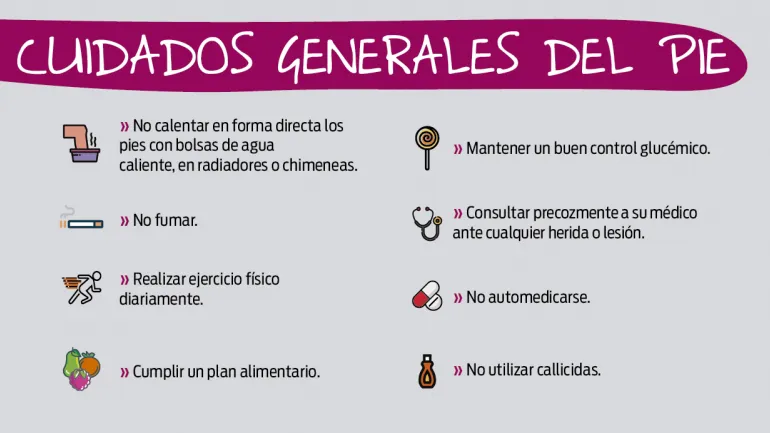The increase in blood sugar, added to other factors that are presented in those who have diabetes, influences our blood vessels and the peripheral and autonomous nervous system, that is, in those neurons and nerves that are located or extended outside the systemcentral nervous towards members and organs.
This nerve commitment is called diabetic neuropathy and can have different manifestations according to the type of compromised nerve fiber.
Diabetic neuropathy is the most frequent chronic complication of diabetes and has the highest prevalence in people with type 2 diabetes, that is, in those who have insufficient insulin production together with an inappropriate use of it.
Generally, the presence and severity of neuropathies are related to the duration of diabetes and the degree of patient hyperglycemia.
This complication affects approximately 50% of patients with more than 25 years of evolution of the disease, being able to be asymptomatic up to half of the cases.The presence of symptoms will depend on harmed nerve fibers and their manifestations can be numbness, pain, cramps or altered pain perception, for example.
The loss of sensitivity produced by diabetic neuropathies favors, together with other predisposing factors (such as peripheral vascular disease or orthopedic alterations) the appearance of injuries that, if not properly treated, may require from hospitalization to an amputation.
Injuries in patients with neuropathy develop more frequently in pressure or rubbing areas, as in the plantar region of the forefoot, pulp and side face of the first finger, back and tips of the fingers.Likewise, in whom the vascular component predominates on the neuropathic, the most common location is the heel, the lateral edges of the feet and bone prominences.
The person with diabetes should be considered a foot at risk, since it presents more susceptibility and probability of suffering injuries such as ulceration, infection and/or gangrene.
People suffering from diabetes should pay attention to the appearance of certain signs in their foot.(Sanatorio Allende)
People suffering from diabetes should pay attention to the appearance of certain signs in their foot.(Sanatorio Allende)
Those who have diabetes should pay attention to the appearance of certain signs, such as dryness, cracks or color changes in the skin;pain when walking;leg fatigue;and presence of cuts, blisters, incarnate nails or calluses.
The possibility that a high percentage of patients be asymptomatic makes it necessary that, both those who know their neuropathy and those apparently healthy, take into account prevention measures to avoid foot injuries.
To take into account ...
Socks:
Use socks without linen, cotton or wool, since they absorb more moisture.
They should not adjust or be very comfortable, and it is recommended to change them twice a day.
Shoes
Never walk barefoot, since it is possible to hurt and not notice it.
Use soft and comfortable shoes, leather, closed, with laces or velcro.Do not wear tight footwear.
Check the interior of them before using them: corroborate that there is no roughness and that the template is smooth.
When buying footwear, it is suggested that it be in the afternoon, since it is the time of the day when the feet are more swollen.The new footwear must begin to gradually use to prevent ampoules formation.
Avoid high tacos, as they can cause the appearance of pressure points.Women up to 5 cm and men no more than 2.5 cm high.
Hygiene and care of the feet:
Touch the water with the elbow to make sure you are not too hot.
Wash theFeet with warm water and neutral soap every day.Wash should not last more than 5 minutes.
Dry well between the fingers and the entire foot by contact and not rubbing.
Het your feet with creams at night, not between fingers.Do not use talcos, powders, alcohol or lotions.
Cut straight nails and not very short after the bathroom, as they will find themselves softer.
Inspection and search for injuries
Observe your feet carefully when you take off your shoes.
Use a mirror to observe the sole of the foot.
In the case of having spots, bruises, blisters or wounds, despite not being painful, consult the doctor.
Currently new therapeutic resources are available that improve the chances of patient recovery.However, feet ulcers are usually difficult to cure, needing in a high percentage of cases the combination of different treatments and several months for total closure.The skin of the area affected by the ulcer, by healing with a different tissue than normal, can have a greater predisposition to injure again, even more if the factors that favored their development are not corrected.
To reduce the pressure in healthy hyperapoyo areas or after the healing of an ulcer, it is necessary to use discharge templates made specifically for each person.They must be changed with a certain frequency depending on the material with which they are made.
Although, fortunately, not all patients with diabetes have neuropathy, educating the patient is a constitutive part of the treatment of this disease.
The incorporation of daily care habits, patient monitoring and glucose control are the basis to avoid injuries and prevent possible complications linked to the diabetic foot.


